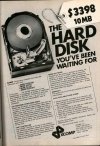M
mike-k
Guest
Sadly, younger generations recognize that icon as "floppy disc", but when I tell them how much data has been on it, they start laughing.
When I even tell them, that once we launched a whole operating system from ONE of these Floppys, they start looking for a good shrink for me...
(gosh I feel so old right now...)
When I even tell them, that once we launched a whole operating system from ONE of these Floppys, they start looking for a good shrink for me...
(gosh I feel so old right now...)







